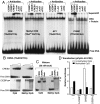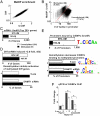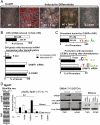CpG methylation of half-CRE sequences creates C/EBPalpha binding sites that activate some tissue-specific genes
- PMID: 21059933
- PMCID: PMC2996703
- DOI: 10.1073/pnas.1008688107
CpG methylation of half-CRE sequences creates C/EBPalpha binding sites that activate some tissue-specific genes
Abstract
DNA methylation of the cytosine in the CpG dinucleotide is typically associated with gene silencing. Genomic analyses have identified low CpG promoters that are both methylated and transcriptionally active, but the mechanism underlying the activation of these methylated promoters remains unclear. Here we show that CpG methylation of the CRE sequence (TGACGTCA) enhances the DNA binding of the C/EBPα transcription factor, a protein critical for activation of differentiation in various cell types. Transfection assays also show that C/EBPα activates the CRE sequence only when it is methylated. The biological significance of this observation was seen in differentiating primary keratinocyte cultures from newborn mice where certain methylated promoters are both bound by C/EBPα and activated upon differentiation. Experimental demethylation by either 5-azacytidine treatment or DNMT1 depletion diminished both C/EBPα binding and activation of the same methylated promoters upon differentiation suggesting that CpG methylation can localize C/EBPα. Transfection studies in cell cultures using methylated tissue-specific proximal promoters identified half-CRE (CGTCA) and half-C/EBP (CGCAA) sequences that need to be methylated for C/EBPα mediated activation. In primary dermal fibroblasts, C/EBPα activates a different set of methylated tissue-specific promoters upon differentiation into adipocytes. These data identify a new function for methyl CpGs: producing DNA binding sites at half-CRE and half-C/EBP sequences for C/EBPα that are needed to activate tissue-specific genes.
Conflict of interest statement
The authors declare no conflict of interest.
Figures




Similar articles
-
Epigenetic modulation of tumor suppressor CCAAT/enhancer binding protein alpha activity in lung cancer.J Natl Cancer Inst. 2006 Mar 15;98(6):396-406. doi: 10.1093/jnci/djj093. J Natl Cancer Inst. 2006. PMID: 16537832
-
All and only CpG containing sequences are enriched in promoters abundantly bound by RNA polymerase II in multiple tissues.BMC Genomics. 2008 Feb 5;9:67. doi: 10.1186/1471-2164-9-67. BMC Genomics. 2008. PMID: 18252004 Free PMC article.
-
CCAAT/enhancer-binding protein-alpha is induced during the early stages of Kaposi's sarcoma-associated herpesvirus (KSHV) lytic cycle reactivation and together with the KSHV replication and transcription activator (RTA) cooperatively stimulates the viral RTA, MTA, and PAN promoters.J Virol. 2003 Sep;77(17):9590-612. doi: 10.1128/jvi.77.17.9590-9612.2003. J Virol. 2003. PMID: 12915572 Free PMC article.
-
CG methylation.Epigenomics. 2012 Dec;4(6):655-63. doi: 10.2217/epi.12.55. Epigenomics. 2012. PMID: 23244310 Free PMC article. Review.
-
Sequence determinants, function, and evolution of CpG islands.Biochem Soc Trans. 2021 Jun 30;49(3):1109-1119. doi: 10.1042/BST20200695. Biochem Soc Trans. 2021. PMID: 34156435 Free PMC article. Review.
Cited by
-
The Mutagenic Consequences of DNA Methylation within and across Generations.Epigenomes. 2022 Oct 4;6(4):33. doi: 10.3390/epigenomes6040033. Epigenomes. 2022. PMID: 36278679 Free PMC article. Review.
-
High-resolution genome-wide DNA methylation maps of mouse primary female dermal fibroblasts and keratinocytes.Epigenetics Chromatin. 2014 Dec 2;7:35. doi: 10.1186/1756-8935-7-35. eCollection 2014. Epigenetics Chromatin. 2014. PMID: 25699092 Free PMC article.
-
Cross-talk between site-specific transcription factors and DNA methylation states.J Biol Chem. 2013 Nov 29;288(48):34287-94. doi: 10.1074/jbc.R113.512517. Epub 2013 Oct 22. J Biol Chem. 2013. PMID: 24151070 Free PMC article. Review.
-
DNA methylation-mediated expression of zinc finger protein 615 affects embryonic development in Bombyx mori.Zool Res. 2022 Jul 18;43(4):552-565. doi: 10.24272/j.issn.2095-8137.2022.031. Zool Res. 2022. PMID: 35616260 Free PMC article.
-
Rainbow trout exposed to benzo[a]pyrene yields conserved microRNA binding sites in DNA methyltransferases across 500 million years of evolution.Sci Rep. 2017 Dec 4;7(1):16843. doi: 10.1038/s41598-017-17236-x. Sci Rep. 2017. PMID: 29203905 Free PMC article.
References
MeSH terms
Substances
LinkOut - more resources
Full Text Sources

